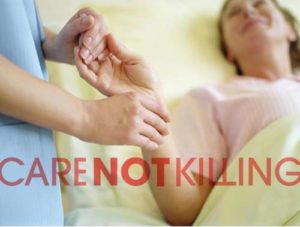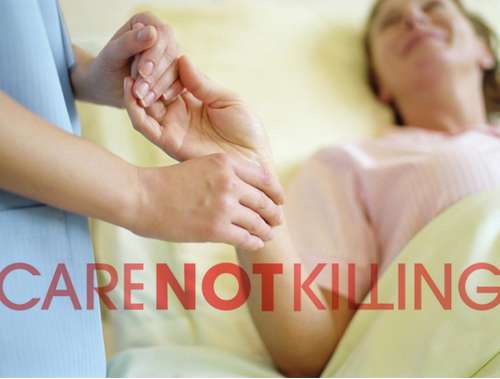End of life Choices Bill Or Please Don’t Kill Anyone
 Commentary – John Fox
Commentary – John Fox
To begin with I should say two things; first, this is not abstract for me. I live with a mild form of cerebral palsy and various associated problems including spastic hemiplegia. I know from first-hand experience how hard it is to be physically vulnerable, to lose control of one’s own body, how hard it can be to depend on other people. From this angle I have every human sympathy with Lecretia Seales and others like her who show to us how real, ugly and frightening death can be. Like everyone with a functional pulse I recognise how hard and difficult this issue is. Advancing medical technology means the debate about ‘the good death’ will not go away.
But secondly, I also know some other things from the same experience. I’d like to share with you why I believe the so-called “choice in dying” bill should not proceed, in fact I want to put it in the waste-paper basket. I say this because for me, this issue is not abstract. When talking about the deaths of people who are sick, terminally ill and disabled, I am not able to forget that we are discussing my life and my death.
One of my first memories is hospital, and especially the crippling sense of vulnerability of a sick four-year-old. I was having corrective surgery and it came time to remove the casts around my feet. My parents tried to distract me while the doctor advanced on me with a blade to cut the cast. I still remember the sense of utter helplessness I felt. The only thing that made feeling this vulnerable okay was my belief that the doctor was here to help me. That I could trust the nurse and the medical professionals. I’ve been in many hospitals since. Every time I lie flat for an x-ray or have my scar tissue mobilised I trust the doctors, their good intentions, their competence, their care. The euthanasia bill strikes at the root of the doctor-patient relationship by making doctors an instrument to kill, not cure. For every articulate (but I think misguided) patient like Lecretia Seales, there are many more who are vulnerable, persuadable or unsure. To use the trust and professional skills special to doctors to enable patients to be killed, even at their own request, is a betrayal of the doctor-patient relationship and the Hippocratic oath: first, do no harm.
I understand, I think, what it is like to feel useless and tortured by your own life. I walk into the pharmacy and the pharmacist says “hello John, is it the usual?”. The ‘usual’ includes fairly high-strength pain meds, drugs to put me to sleep, drugs to wake me up again, and drugs to make life tolerable while I’m awake. There are days when my feet refuse to work, when I fall and have to get scraped off the footpath, when I lie awake, staring at the ceiling wondering what use my life is. But that is not all I have. As my friends and family remind me regularly, even if I am no use to the economy and even little use to myself, I am valuable to them simply by existing.
If a healthy and able bodied 32 year-old went to the doctor tomorrow and asked to die, there would be severe concern. The doctor would ask questions about the context of his life, his relational support, what it is that makes his life no longer worth living. The doctor’s first concern would be to get him to see the bigger picture, the interconnectedness and belonging we share as human beings and members of the human family. Give that 32 year-old a terminal illness or like me, an incurable disability, and in some jurisdictions death becomes thinkable, even allegedly the best option. I don’t know what to call that, other than fear of disability. As modern western people we pride ourselves on our autonomy, our power, our capacity. It is one of our deepest and most unspoken fears – the fear of disability, disfigurement, loss of control and death. It is for this reason that for instance the large majority of down-syndrome children never arrive. It is for this reason that we shy away from the mentally ill, the elderly, and the sick hoping that if we crowd them away, we will not become like them. If we pride ourselves on being an inclusive society, a fair society and a society of solidarity we must change and confront this fear. It is at the moment of death we can measure the practical charity of our society. In our country palliative care is patchy. It took me six months to access pain services in our largest city – thank God I don’t live in the Northern Territory. There are also multiple reports of the abuse and neglect of the elderly in rest homes. I argue that we must uphold solidarity with disabled people. We must insist on our connectedness as well as our autonomy. We must remind even those tempted to forget that quote “each of us is willed, each of us is loved, each of us is necessary”. We have rightly abandoned the asylum mentality of the 1970s. Let us make another step and declare, as our law already does, we are all in this together. The euthanasia bill creates a category of people who are killable. That is wrong.
I know slippery slope arguments get bad press coming somewhere around that old chestnut “will somebody think of the children?”. In this case, I think a slippery slope argument can be justified, but rather, I chose a different one. Once you have created the category, whether it is terminally ill people, incurable, or simply people who wish to die, the category will inevitably creep. Unless parliament were to pass a law setting out the medical details of everyone who wishes to die and naming them one by one, the category is bound to be and become broader than intended. The DPB was once an emergency benefit for battered wives. The abortion law was intended for the rare hard case. And welfare was created as a supplement to work. What we see in all three examples is the phenomenon I talk about; not so much slippery slope, but category creep. The law becomes broader than intended, then easily expandable, then a rule, in spite of safe-guards. The only way to stop category creep is not to create the category in the first place.
I know from experience, both mine and other peoples’, what disability looks like. I have also seen death, and the process leading up to it. They expose the deepest questions of the human soul and make concrete the challenge we too often ignore: the challenge to care. It is this challenge I wish to leave you with. Whether it is the elderly, the disabled, the young or the unborn, New Zealand faces a choice. We can rise to our best selves: fair, decent, brave and compassionate, or push the red button and sweep up the mess. For me and the many disabled people who think as I do (although not all) we hope that we will be wise enough, kind enough and gutsy enough to choose the first option. Maintain our dignity. Put the bill in the bin.
Reprinted with Permission of Author







